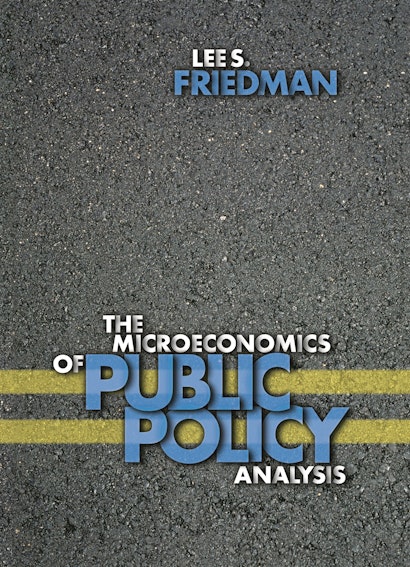This book shows, from start to finish, how microeconomics can and should be used in the analysis of public policy problems. It is an exciting new way to learn microeconomics, motivated by its application to important, real-world issues. Lee Friedman’s modern replacement for his influential 1984 work not only brings the issues addressed into the present but develops all intermediate microeconomic theory to make this book accessible to a much wider audience.
Friedman offers the microeconomic tools necessary to understand policy analysis of a wide range of matters of public concern—including the recent California electricity crisis, welfare reform, public school finance, global warming, health insurance, day care, tax policies, college loans, and mass transit pricing. These issues are scrutinized through microeconomic models that identify policy strengths, weaknesses, and ideas for improvements. Each chapter begins with explanations of several fundamental microeconomic principles and then develops models that use and probe them in analyzing specific public policies.
The book has two primary and complementary goals. One is to develop skills of economic policy analysis: to design, predict the effects of, and evaluate public policies. The other is to develop a deep understanding of microeconomics as an analytic tool for application—its strengths and extensions into such advanced techniques as general equilibrium models and pricing methods for natural monopolies and its weaknesses, such as behavioral inconsistencies with utility-maximization models and its limits in comparing institutional alternatives. The result is an invaluable professional and academic reference, one whose clear explanation of principles and analytic techniques, and wealth of constructive applications, will ensure it a prominent place not only on the bookshelves but also on the desks of students and professionals alike.
Lee S. Friedman is an economist and Professor of Public Policy at the Goldman School of Public Policy, University of California, Berkeley. A recipient of the David N. Kershaw Award for distinguished public policy research, he is the author of Microeconomic Policy Analysis (McGraw-Hill) and numerous articles in scholarly journals. He is the former editor of the Journal of Policy Analysis and Management, the official journal of the Association for Public Policy Analysis and Management, whose presidency he also held.
"Teachers and students alike will be thanking Lee Friedman for accomplishing what all too few textbook authors do: breathing the vibrant life of practical examples into the abstract principles of economic analysis. This book links sound economic theory to scores of policy problems, presented in rich institutional detail. It will engage, enlighten, and captivate participants in both public policy and mainline economics courses for years to come."—Henry J. Aaron, Brookings Institution
"Getting the economics right is one of the first tasks to getting public policy right. In Lee Friedman's new text, we now have the thorough and thoughtful treatment we need to train the next generation of policymakers and their advisors. Friedman makes sure the student sees the strengths and weaknesses of each tool in the economist's kit. To Harry Truman's chagrin each application and substantive topic gets a balanced 'pro vs. con' presentation. And today's policy analysts, myself included, need this book within easy reach, on the shelf between Varian and Rawls."—Robert P. Inman, University of Pennsylvania
"An important book. It should have a major impact in schools of policy, planning, and administration, and even in some economics departments. Friedman does a great job of applying the theory to important real-world problems."—David Howell, New School University
"The Microeconomics of Public Policy Analysis will quickly become the most widely used text in graduate schools of public affairs and will be an attractive text for use in advanced undergraduate economics courses. The main argument is that microeconomic theory provides a strong and persuasive foundation for designing policies to achieve efficiency and equity in market and nonmarket settings. This text is significant . . . the best to bring together economic rigor and policy applications."—Samuel L. Myers, Jr., Roy Wilkins Professor of Human Relations and Social Justice, Hubert H. Humphrey Institute of Public Affairs, University of Minnesota
"Lee Friedman's new text is just what's needed to prepare the next generation of policy analysts for the challenges ahead. It provides a strong foundation for a public-policy course that could serve either as a complement or substitute for a traditional intermediate microeconomics course. Friedman is superb at developing extended real-world examples that provide a grounded sense of both the power and the limitations of economic analysis."—Philip J. Cook, Duke University

